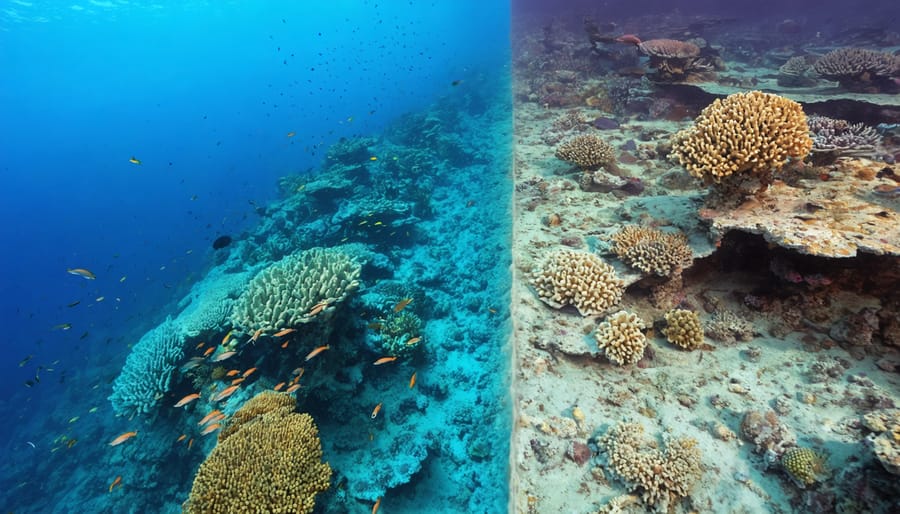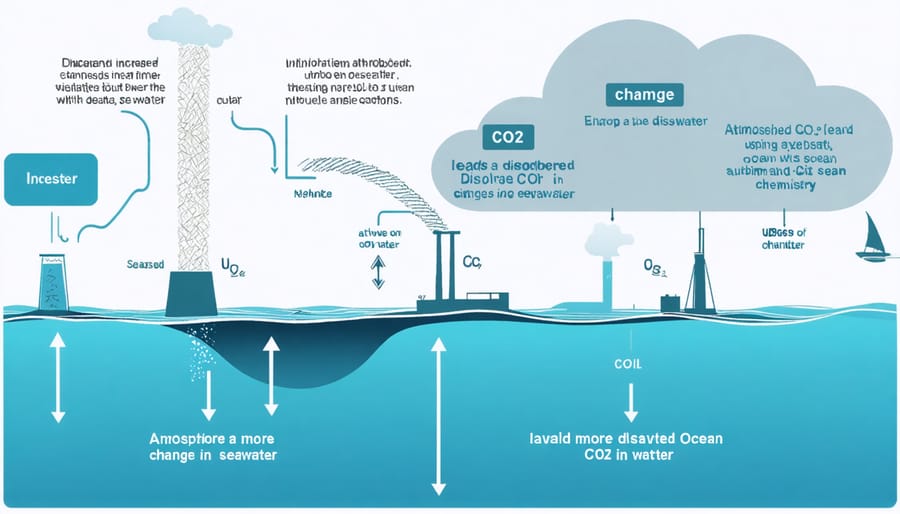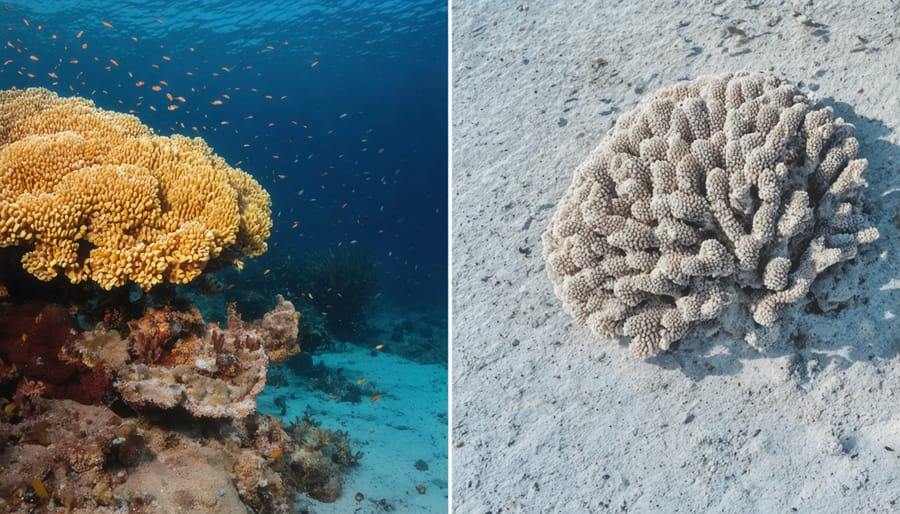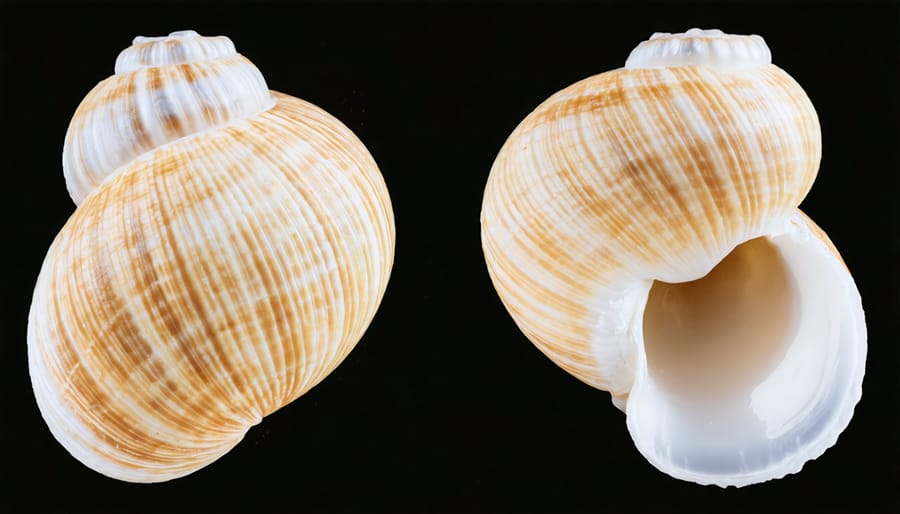
Ocean acidification, the silent threat wreaking havoc on our marine ecosystems, is a crisis we can no longer afford to ignore. As carbon dioxide levels in the atmosphere soar, our oceans absorb more and more of this greenhouse gas, triggering a devastating chemical reaction that lowers the pH of seawater. This insidious process, often referred to as ocean acidification, is eroding the very foundation of marine life – the delicate balance of chemistry that allows countless species to thrive.
The consequences are far-reaching and catastrophic. From the tiniest plankton to the mightiest whales, no creature is spared from the ravages of acidification. Coral reefs, the vibrant underwater cities teeming with biodiversity, are slowly dissolving as the acidic waters eat away at their calcium carbonate structures. Shellfish struggle to build their protective shells in this corrosive environment, leaving them vulnerable to predators and disease. The entire marine food web is under siege, as the building blocks of life crumble beneath the weight of human-induced climate change.
But all is not lost. By understanding the mechanisms behind ocean acidification and its devastating impact on marine life, we can take urgent action to mitigate this crisis before it’s too late. From reducing our carbon footprint to supporting marine conservation efforts, each one of us has the power to make a difference. The fate of our oceans hangs in the balance – it’s time to join forces and fight for the future of our planet’s most precious resource.
The Chemistry of Ocean Acidification

The Carbonate System
Dissolved carbon dioxide in the ocean alters the delicate balance of the carbonate system. When CO2 dissolves, it reacts with water to form carbonic acid, which dissociates into hydrogen ions and bicarbonate. The increased hydrogen ion concentration lowers the pH, leading to ocean acidification. This process also reduces the availability of carbonate ions, which many marine organisms rely on to build their calcium carbonate shells and skeletons. As the ocean absorbs more anthropogenic CO2, the shift in the carbonate system makes it more difficult for calcifying organisms, such as corals, mollusks, and some plankton, to construct and maintain their protective structures. This disruption of the carbonate balance has far-reaching consequences for marine biodiversity and ecosystem health, as it affects the very foundation of many ocean food webs and habitats.
Declining pH Levels
Over the past 200 years, the pH of the ocean surface has decreased by approximately 0.1 units, a 30% increase in acidity. This change is primarily driven by the absorption of atmospheric carbon dioxide (CO2) by the oceans. As CO2 levels continue to rise due to human activities like fossil fuel combustion and deforestation, ocean acidification is expected to intensify. Projections based on different CO2 emission scenarios suggest that by the end of the 21st century, the average surface ocean pH could drop by an additional 0.3 to 0.4 units, resulting in a 100% to 150% increase in acidity compared to pre-industrial levels. Such rapid changes in ocean chemistry have not been experienced for millions of years and pose significant challenges for marine life to adapt. The rate and severity of future acidification will largely depend on the trajectory of global CO2 emissions in the coming decades.
Impacts on Shelled Animals
Coral Reefs in Peril
Ocean acidification poses a grave threat to coral reefs, the vibrant underwater ecosystems that harbor an astounding diversity of marine life. As the ocean absorbs excess carbon dioxide from the atmosphere, it becomes more acidic, making it harder for corals to build their calcium carbonate skeletons. This process inhibits the growth of new coral and weakens existing structures, leaving reefs more vulnerable to erosion and damage from storms. Rising acidity also disrupts the delicate balance of reef ecosystems, causing coral bleaching events and die-offs that can devastate entire coral reefs. As these vital habitats degrade, they lose their ability to support the countless species that depend on them for food, shelter, and breeding grounds. Urgent action is needed to reduce carbon emissions and protect coral reefs from the devastating impacts of ocean acidification before it’s too late.

Crumbling Shells
As ocean acidification intensifies, many shelled organisms like mollusks and certain plankton species face increasing challenges in building and maintaining their protective shells. The process of calcification, where these creatures use carbonate ions to construct their calcium carbonate shells, becomes more difficult as acidity rises and carbonate ion availability drops. Consequently, shells may grow more slowly, become thinner and more brittle, or even start dissolving. Larval and juvenile life stages are especially vulnerable. Struggling to build strong shells can reduce these organisms’ defenses against predators and environmental stresses, impacting their survival and the ecosystems they support. By disrupting the formation of shells at the foundation of marine food webs, acidification threatens to destabilize entire ocean communities.
Effects on Marine Food Webs

Plankton Problems
Ocean acidification can have profound effects on the microscopic plankton that form the foundation of marine food webs. As the ocean absorbs excess atmospheric carbon dioxide, the resulting chemical changes can impair the growth and survival of certain planktonic species. For example, many plankton build calcium carbonate shells, which become more difficult to construct in acidified water. This can lead to shifts in the composition of plankton communities, with ripple effects throughout the ecosystem. Some species may decline while others thrive, potentially disrupting the delicate balance that supports marine life. Additionally, changes in plankton abundance and nutritional quality can impact the fish, birds, and mammals that depend on them for food. Protecting plankton is crucial for maintaining the health and resilience of our oceans in the face of acidification.
Threats to Fisheries
Ocean acidification poses significant threats to commercially important fish stocks and global seafood supplies. As the food web is disrupted by the decline of calcifying organisms and altered species interactions, the abundance and distribution of many fish species may change. Larval fish are particularly vulnerable, as they rely on plankton affected by acidification for survival. Declining shellfish populations could have ripple effects, reducing prey availability for economically valuable fish. Degraded coral reefs, a critical habitat and nursery for many fish species, would compound these impacts. Acidification also impairs the sensory abilities and behavior of some fish, potentially affecting their survival and reproduction. As a result, acidification could lead to substantial declines in fish catches, threatening food security, livelihoods, and the economies of coastal communities worldwide. Urgent action is needed to mitigate these risks.
From Science to Solutions
Monitoring and Experiments
Scientists are actively monitoring ocean acidification trends through long-term field observations, tracking changes in seawater chemistry and marine life populations over time. Controlled laboratory experiments allow researchers to study how specific species respond to simulated acidification conditions, revealing physiological effects and adaptability thresholds. By combining real-world data with experimental insights, scientists can build predictive models to forecast acidification’s future impacts on marine ecosystems. Citizen science initiatives also engage the public in data collection, expanding the scope of monitoring efforts. These multi-pronged approaches are crucial for understanding the full extent of acidification’s consequences and informing strategies to mitigate its effects on the delicate balance of ocean life. As the scientific community works tirelessly to unravel this complex issue, their findings underscore the urgent need for action to curb carbon emissions and protect the invaluable biodiversity of our marine world.
Adaptation and Mitigation
To mitigate the impacts of ocean acidification, urgent action is needed to reduce CO2 emissions from human activities. Protecting vulnerable ecosystems, such as coral reefs and kelp forests, can help build resilience against acidification. Marine protected areas and sustainable fishing practices are crucial for preserving biodiversity. Scientists are also exploring ways to help species adapt, such as selective breeding of acid-tolerant organisms. Restoration efforts, like coral gardening and oyster bed rehabilitation, offer hope. However, the most effective solution is addressing the root cause of the problem – climate change. Transitioning to clean energy, improving energy efficiency, and adopting sustainable lifestyles are all necessary steps. The success of marine protected areas can be seen in various conservation efforts, as detailed in 7 Remarkable Ways Marine Protected Areas Are Saving Our Oceans. By working together and taking action now, we can help preserve the delicate balance of marine life for future generations. Everyone has a role to play, whether through supporting conservation organizations, making eco-friendly choices, or advocating for policy change. Together, we can ensure a thriving ocean for all.
Conclusion
Ocean acidification poses a grave threat to marine life, with far-reaching consequences for the health and resilience of our planet’s seas. As atmospheric carbon dioxide levels continue to rise, driven by human activities like fossil fuel combustion and deforestation, more CO2 is absorbed by the oceans, altering their chemistry and lowering their pH. This acidification disrupts the delicate balance of marine ecosystems, impacting everything from the smallest plankton to the largest whales.
Corals, shellfish, and other calcifying organisms face particular challenges in acidifying oceans, as the lower pH makes it harder for them to build and maintain their protective structures. As these foundation species struggle, the entire ecosystem is affected, with ripple effects on food webs, biodiversity, and ecosystem services. Fisheries, coastal communities, and economies that depend on healthy oceans are also at risk.
Tackling ocean acidification requires urgent action to address the root cause: climate change. By reducing greenhouse gas emissions, transitioning to clean energy, and protecting carbon-absorbing ecosystems like forests and wetlands, we can slow the rate of acidification and give marine life a chance to adapt. Supporting research, monitoring, and conservation efforts is also crucial to understanding and mitigating the impacts of acidification.
As individuals, we all have a role to play in protecting our oceans. By making sustainable choices, advocating for climate action, and supporting marine conservation, we can help ensure a healthier future for our seas and the countless species that call them home. The time to act is now – for the sake of our oceans, our planet, and all the life that depends on them.
jessica
Ava Singh is an environmental writer and marine sustainability advocate with a deep commitment to protecting the world's oceans and coastal communities. With a background in environmental policy and a passion for storytelling, Ava brings complex topics to life through clear, engaging content that educates and empowers readers. At the Marine Biodiversity & Sustainability Learning Center, Ava focuses on sharing impactful stories about community engagement, policy innovations, and conservation strategies. Her writing bridges the gap between science and the public, encouraging people to take part in preserving marine biodiversity. When she’s not writing, Ava collaborates with local initiatives to promote eco-conscious living and sustainable development, ensuring her work makes a difference both on the page and in the real world.
